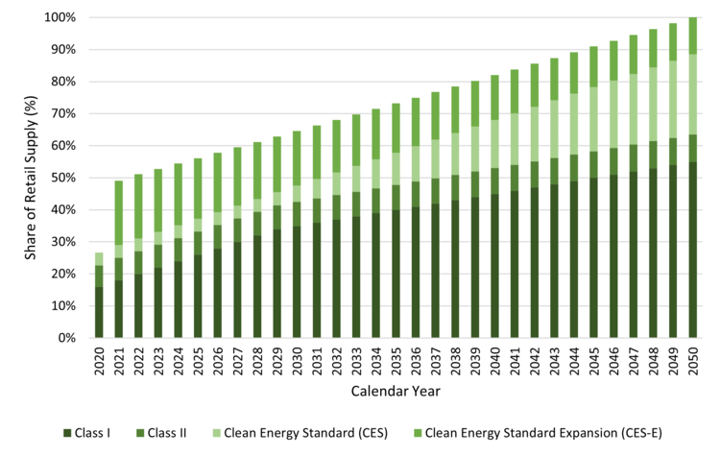
by Zac Bloom, Vice President, Head of Sustainability & Renewables
EMISSIONS ACCOUNTING
A Renewable Energy Credit “REC” is a tradeable certificate that represents the environmental attributes of one megawatt-hour (“MWh”) of electricity generated by a renewable energy source. [1] One REC is produced for each MWh of renewable electricity generated. By purchasing and retiring (i.e., not reselling) a REC, an entity can offset its “Scope 2” emissions associated with electricity purchased and imported from the grid.
Scope 2 emissions are offset one-for-one – that is, a REC must be retired for each MWh of grid electricity imported. While a REC must be purchased and retired on the entity’s behalf to offset its Scope 2 emissions, the actual purchaser does not have to be entity itself. In fact, most of the RECs that will need to be retired by any entity in the coming decades will be acquired and retired by their retail electricity supplier pursuant to the supplier’s obligations under that state’s Renewable Portfolio Standard (“RPS”) law and regulations. RPS requires that all suppliers serving retail load in that state meet their supply obligations by purchasing a certain percentage of electricity from renewable generators. Retail electricity suppliers do this by purchasing and retiring RECs in exactly the same way that most entities would do, but for the actions of the supplier.
We refer to these RECs retired by a retail supplier as compliance RECs. Compliance RECs are not cheap. For instance, in Massachusetts in 2020, a supplier had to pay roughly $250,000 to satisfy the RPS obligation for a retail end user that used 10,000 MWh for the year. In 2020, the cumulative RPS obligation was 27% of retail sales [2]. With the addition of the Clean Energy Standard Expansion [3] (“CES-E”), the cumulative RPS obligation increased to 49% in 2021 and will subsequently increase by an average two percentage points a year until it reaches approximately 80% in 2040 and 100% in 2050. [4] These compliance obligations are presented in Figure 1 by program component.
Figure 1: Massachusetts Renewable Energy Compliance Obligations: 2020 – 2050

The compliance REC retirements made by a retail supplier are made on behalf of the end users and provide the same degree of Scope 2 emissions offset as would be the case if that same end user acted as its own retail supplier and made the compliance REC purchases and retirements itself.[5] Because the Massachusetts RPS percentages are less than 100% for the next three decades (assuming current state law), any entity that wishes to offset 100% of its Scope 2 emissions must directly purchase and retire RECs for that portion of its electricity grid purchases not covered by the actions of its supplier. We refer to these as supplemental RECs.
OPTIONS FOR PURCHASING AND RETIRING SUPPLEMENTAL RECS
The first option an entity must consider is whether it is feasible to acquire and retire supplemental RECs from renewable generation located on their property. This type of renewable generation meets two important criteria – additionality and geographic proximity. To the extent that any entity elects to install a new rooftop, ground-mounted, and/or solar parking canopies onsite, they can choose to retain and retire the RECs generated by the behind-the-meter systems. The challenge with this option is that the actual or implied costs of these RECs is often quite high, and it may be necessary to sell these RECs into high value compliance markets to make the economics of onsite renewables attractive.
Another consideration when thinking about onsite behind-the-meter renewables is the available space, between rooftops, land for ground mounted systems, or parking canopies. Most end users do not have sufficient space on their premises to build a system that would offset a significant amount of the imported electricity to make this option viable for offsetting the entirety of their Scope 2 emissions. For this reason, onsite behind-the-meter systems should be viewed as the 2nd option to be utilized or considered over and above compliance RECs but most end users will require additional REC procurement options to offset the balance of their Scope 2 emissions.
The second option is for an entity to purchase and retire supplemental RECs from existing renewable generators not located on the entity’s premises. These RECs could be from existing large-scale solar and/or wind projects anywhere in the U.S. As with the first option, the entity can claim offsets to its Scope 2 emissions by purchasing and retiring RECs from any renewable generation facility. This option can offer very low costs but sacrifices additionality and may sacrifice geographic proximity. We refer to this option as the Green-e option, described in more detail below.
The third option is for an entity to execute one or more long-term virtual power purchase agreements (“VPPA”) with a project developer to construct a new renewable generator located off the entity’s premises, either in state or out of state. [6] These offsite projects could range in size from small community-scale solar (5 - 10 acres) to utility-scale generation projects (250 - 500+ acres). There are several examples of entities executing VPPAs in recent years, including several colleges in Massachusetts and Maine aggregating together to execute a VPPA with a new utility-scale solar project in Maine. [7] This option provides additionality and perhaps geographic proximity but is likely to cost significantly more than the Green-e option depending on the geographic location of the project and the value of energy produced in that specific region.
GREEN-E RECS
A common way entities acquire and retire RECs to offset their Scope 2 emissions is by purchasing RECs from existing generators in voluntary markets. Voluntary markets refer to REC sales where an end user acquires and retires RECs on a voluntary basis; that is, the purchase and the retirement of those RECs does not help an end user satisfy compliance obligations under a state renewable portfolio standard, regional greenhouse gas trading program, or other mandated program.
There are numerous sellers and marketers of RECs serving the voluntary market. An entity can conduct a competitive solicitation process to select a provider of voluntary RECs. When conducting a solicitation for RECs, the entity would need to decide which certification and verification program to utilize for contracted RECs. There are several different programs that REC sellers and buyers operating in the voluntary REC market can use to certify and verify that purchased RECs are credibly sourced from renewable generation and are not being counted toward other institutions’ emissions inventories.
Green-e Energy is the leading independent certification and verification program for voluntary REC purchasing in the U.S. The Green-e certification program is administered by the Center for Resource Solutions, a nonprofit organization based in San Francisco, California. To be certified as offering a Green-e product a REC seller is required to disclose the quantity, type, and geographic source of each REC certified. There are four primary criteria for Green-e certification. First, electricity must come from eligible generation sources, which include wind, solar, geothermal, and certain biomass, and low-impact hydropower plants. Second, only renewable generators built within the last 15 years of a sale date are certified under the Green-e label. For Green-e RECs sold in 2020, eligible generators had to have begun operations or been repowered after 2006. Third, Green-e RECs cannot be used by a party to satisfy a state-mandated renewable energy program. Lastly, Green-e RECs sold in a given calendar year must be generated within the 12 months of that calendar year, the six months before the calendar year began, or the three months after the calendar year has ended. This creates a 21-month window of eligible generation dates from which renewable energy generation can be used toward Green-e certified sales in any given year.
Historically, the most attractive aspects of Green-e RECs are their low cost and short contract terms. The price of Green-e RECs over the last decade has been approximately $1 per MWh, inclusive of transaction fees. At this price, REC costs are a fraction of the cost CES estimates an entity would pay for mandated renewable energy programs in most states, or of the potential cost an entity may pay for RECs from new in-region wind or solar generators today. Further, an entity would not have to commit to 10- to 20-year contract terms like it would for a new renewable generator through a PPA or VPPA. Unbundled (the RECs and energy generation are decoupled) RECs can be purchased through one-time transactions in the spot market or through short-term contracts running between one and five years, providing buyers flexibility to modify contracted volumes or purchasing strategies over time.
While purchasing RECs from existing generators has historically provided a lower cost, flexible means for an entity to claim Scope 2 emissions offsets, this approach is increasingly being viewed critically by peers, boards of directors, students, communities, and policymakers. Criticism is based in the contention that many existing renewable generators that produce Green-e RECs would likely be operating without the REC sales revenue, and therefore the purchase of RECs does not have an incremental impact in reducing global emissions from electricity generation – that is, the project lacks additionality. [8]
Figure 2: Green-e RECs Trailing 12 Month Price History

Over the last year, the cost of Green-e RECs has increased drastically – into the $5-$7/REC range. This 5x-7x increase as of this writing is consistent for vintage years 2021, 2022 and 2023, while 2024 is trading in the $4-$5/REC range which is still much higher than the $1/REC historic trading range but is showing some relief in the future from the current market pricing. While the cost increase doesn’t put a Green-e REC in the same price range as a new compliance market Class 1 REC or Solar Renewable Energy Credit (SREC), higher cost is likely to make end users question the validity of a Green-e voluntary market strategy given the increased scrutiny by stakeholders that have a preference for new renewable generation facilities that provide additionality and will impact the overall generation portfolio.
CONCLUSION
CES believes that every end user is different and there is no one REC option that makes sense in the marketplace to solely focus on. Each strategy should start with a firm understanding of how state RPS compliance RECs fit into a 10- and 20-year outlook. From there, depending on the reduction goals, the focus should be on new renewable energy facilities (either onsite or offsite) that offer additionality. Unbundled voluntary market RECs should typically be the final option. Keep in mind that state and regional incentive programs change rapidly and can have an enormous impact on viability of various REC options and strategies. Work with your Energy Services Advisor to understand exactly how the various REC options available fit into your own carbon reduction goals and strategy.
[1] It is important to note, that entities purchase of RECs does not provide physical delivery of the electricity generated associated with those RECs. Therefore, REC purchases have no direct impact on its decisions regarding how to procure their electricity supply.
[2] This percentage includes all RECs qualifying for Massachusetts’ Clean Energy Standard (includes Class I), Clean Energy Standard Expansion, and Class II RECs that are associated with generation from plants that do not qualify as Class I but whose generation is nevertheless considered renewable by the Commonwealth. The Alternative Energy Portfolio Standard and Clean Peak Standard obligations are not included in this calculation because the two programs are structured to mandate alternative energy sources, not renewable electricity generation.
[3] CES-E aims to enable Massachusetts to claim the emissions credit from legacy zero emissions generation resources in New England and adjacent regional grids, including but not limited to nuclear generation from Millstone and Seabrook Nuclear Stations and Quebec hydro imports from Phase II and the proposed New England Clean Energy Connect transmission line.
[4] The 100% RPS outcome in 2050 is an estimate. The CES-E compliance obligation starts at 20% of retail load in 2021 but in subsequent years is based on a formula that reduces the obligation if statewide retail electric sales increase. We have assumed state retail sales increase an average 2.0% per year between 2020 and 2050, resulting in a roughly 75% increase in statewide electric load compared to today. The actual level of load growth over the next 30 years will depend on the extent to which the state drives electrification of space heating and transportation.
[5] We note that they also provide the same degree of emissions offset as would be the case where an entity retires RECs from a renewable energy project it owns that is located behind their meter. Any distinction drawn between these three cases – (a) non-compliance RECs from renewable generation located behind the meter, (b) compliance RECs purchased by the entity acting as its own retail electricity supplier, and (c) compliance RECs purchased by the entities retail electricity supplier are artificial. They are not based on differences in emission consequences of the three cases, because there are no differences.
[6] This contract could be structured in two ways: for physical delivery of contracted energy and RECs to the entity if the generator is located in the same region or as a virtual settlement whereby the entity only acquires RECs from the project. A virtual settlement can be used in all cases regardless of whether the generator is located in or outside the region.
[7] More information on Bowdoin, Williams, Amherst, Hampshire, and Smith Colleges’ VPPA can be found at https://www.competitive-energy.com/news/2019/10/24/five-leading-liberal-arts-college-partner-to-create-new-solar-energy-facility-in-maine.
[8] A related argument among critics of unbundled Green-e RECs is that investment in new wind generation, the largest source of unbundled Green-e RECs in the country, has been largely driven by federal incentives for renewable energy and not by project owners’ expectations of REC revenue as a primary value stream. This, however, is not as significant a source of criticism as the additionality issue.
Photo by
